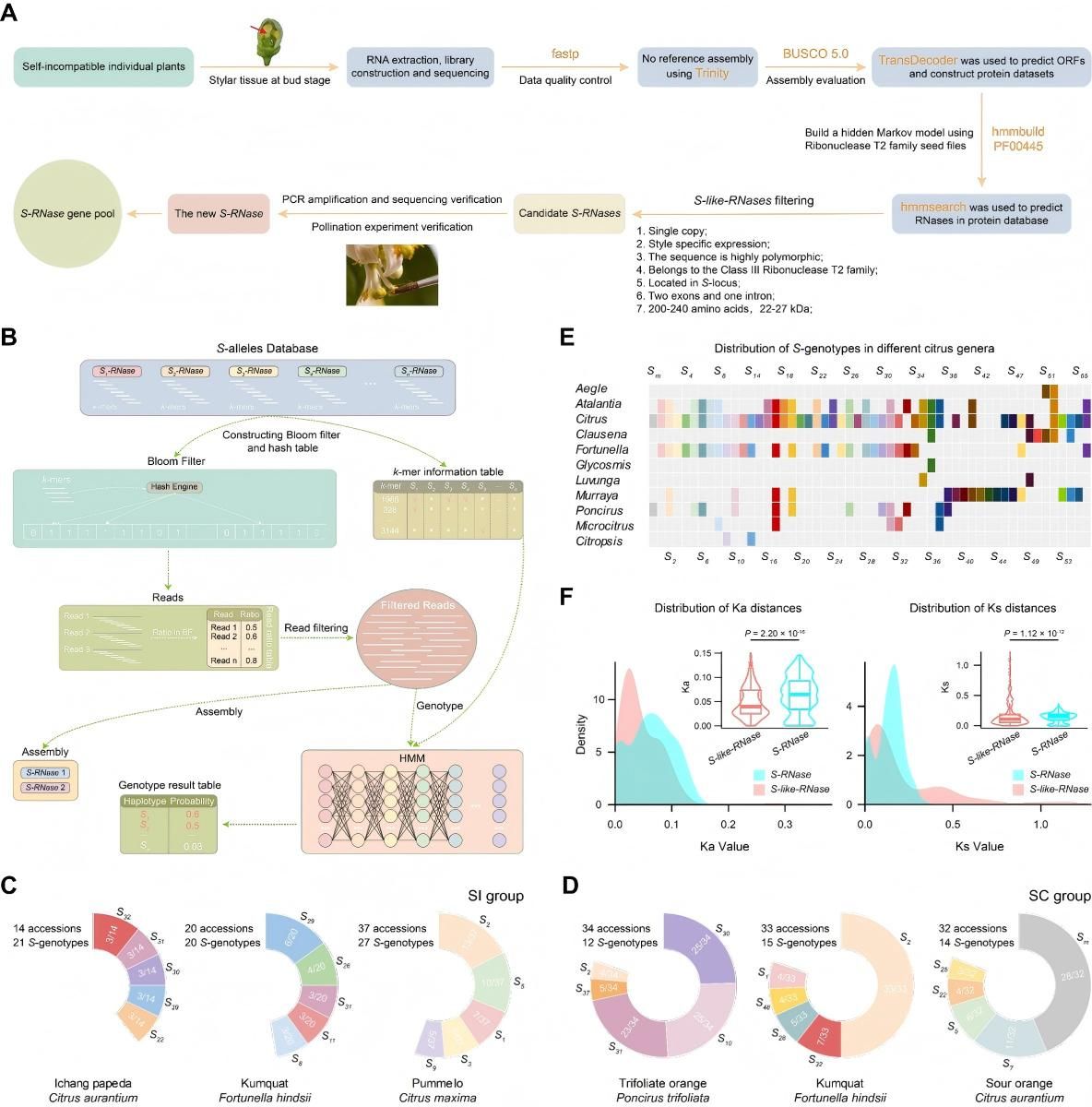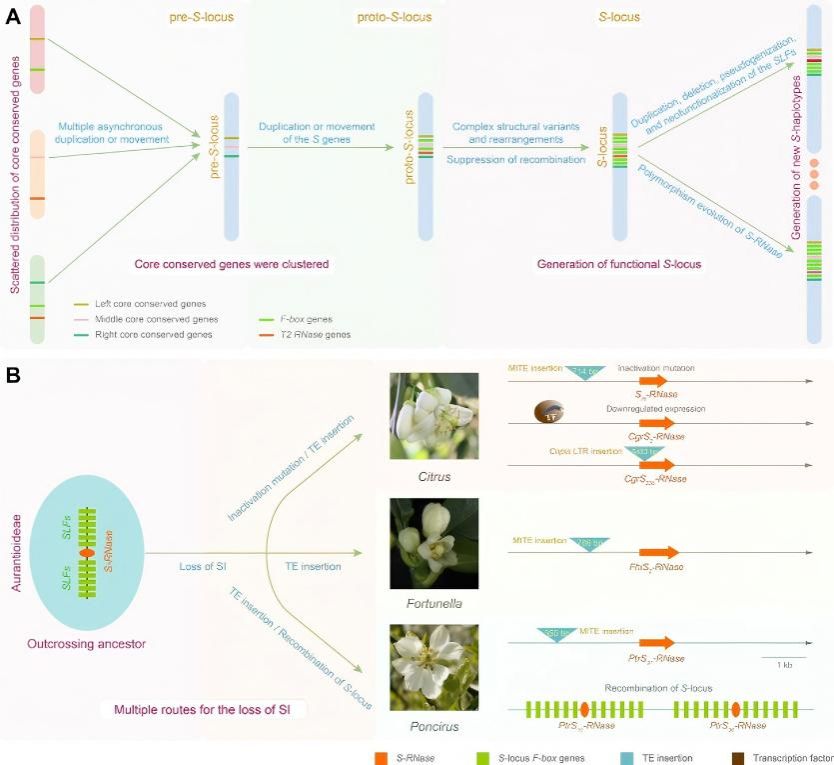南湖新闻网讯(通讯员 胡健兵)近日,我校园艺林学学院、果蔬园艺作物种质创新与利用全国重点实验室、湖北洪山实验室邓秀新院士团队柴利军教授课题组,通过构建首个覆盖柑橘亚科11个属的泛S位点(pan-S-locus)图谱,成功阐明柑橘亚科SI的起源与演化机制。研究成果以“Pan-S-locus analysis reveals insights into the origin and evolution of self-incompatibility in the orange subfamily”为题发表于Genome Biology。该发现为深入解析植物类群SI系统的演化提供了重要范式,并将为系统揭示被子植物SI系统的宏观进化规律奠定基础。
自交不亲和性(Self-Incompatibility, SI)是被子植物进化过程中形成的重要生殖策略,旨在防止自交、促进异交,从而维持物种遗传多样性。柴利军教授课题组前期研究首次证实芸香科柑橘亚科属于以S-RNase介导的配子体自交不亲和系统,控制其自交不亲和系统的雌蕊决定因子为S-RNase(Nature Plants,2020),雄蕊决定因子为SLF (S-Locus F-box)(Journal of Experimental Botany,2024 封面)。并且系统明确柑橘属(Nature Plants,2020;Horticulture Research,2021)、金柑属(Plant Biotechnology Journal,2024 封面)枳属(Plant Communications,2024)资源独特亲和演化机制及下游的复杂调控网络(Plant Physiology,2024)。但有关S位点(S-locus)的表征及演化机制始终还未有明显进展。
被子植物的SI多由单一高多态性超基因S位点(S-locus)控制,该位点包含两类紧密连锁的S决定因子基因,分别在花柱组织和花粉中特异性表达。由于S位点具有高多态性、重组抑制、富含转座元件(Transposable Elements, TE)等特征,且其长度在不同家族中可从数百kb跨越至数十Mb,鲜有物种实现S位点的完整重构,这极大制约了该超基因进化机制的研究。自S-RNase介导的SI系统关键基因被鉴定以来,S位点的表征及演化机制始终是学界关注焦点。
研究利用Revio测序技术完成S单倍型组装,绘制出涵盖柑橘亚科11个属88个S单倍型的泛S位点图谱。基于S位点基因与转座元件的精准注释,团队首次揭示柑橘亚科S-locus的独特结构特征。系统进化分析证实,柑橘亚科中S-like-RNase与S-RNase、nonS-locus F-box与SLFs具有共同起源。研究同时发现,核心保守基因在S基因聚集前已形成S位点前体,基因组中的RNase及F-box基因被选择为S基因的潜在祖先,最终促成柑橘亚科S-locus超基因簇的形成。

通过比较S位点外群同源序列的核心保守非S基因片段,研究揭示柑橘亚科S位点起源于多次异步复制事件:首先由核心保守非S基因簇组装形成S位点前体(Pre-S-locus);随后通过S基因迁移或复制建立原型S位点(Proto-S-locus);最终经复杂结构变异、重排及重组抑制形成功能性S位点。转座元件在驱动S基因进化中发挥关键作用,其活跃常伴随假基因化事件及自交不亲和性丢失。本研究对柑橘亚科泛S位点的全面解析,为破解自交不亲和系统的复杂性奠定关键基础,并为植物生殖策略的演化机制研究开辟新视角。

华中农业大学已出站博士后胡健兵(现安徽农业大学副教授)、华中农业大学信息学院杜泽臻博士为论文共同第一作者;华中农业大学园艺林学学院柴利军教授、信息学院焦文标教授及胡健兵博士为通讯作者。华中农业大学刘晨晨博士、文豪博士生、刘聪博士生参与研究;湖南省农业科学院陈鹏研究员、肇庆学院吉前华教授、英国Aberystwyth大学Maurice Bosch教授、华中农业大学邓秀新院士、叶俊丽副研究员及林宗成教授为本研究提供重要指导。研究获国家重点研发计划(2023YFD1200100)、中央高校创新基金项目(ZYGXONJSKYCXNLZCXM-A5)、国家自然科学基金(32270685, 32302489)及湖北省自然科学基金(2023AFB094)资助。
论文链接:https://genomebiology.biomedcentral.com/articles/10.1186/s13059-025-03817-x
【英文摘要】
Self-incompatibility is controlled by a highly polymorphic supergene complex, the S-locus, which is structurally complex, rich in repetitive sequences, and varies in length from hundreds of kilobases to tens of megabases across different plant families. Due to these challenges, the S-locus has been fully reconstructed in only a few species, limiting our understanding of its evolutionary dynamics.
This study systematically explores the evolutionary mechanisms and structural characteristics of the self-incompatibility system mediated by S-RNase in the Aurantioideae (orange subfamily) of Rutaceae. We construct a pan-S-locus framework spanning 11 genera within the orange subfamily from 14 newly assembled genomes from representative accessions and the analysis of 41 published citrus genomes. Our analyses reveal significant structural variations and transposable element (TE)-driven pseudogenization of SLF genes. By constructing a comprehensive library of S-RNases and developing a novel genotyping pipeline, we reveal divergent frequencies of S-RNases between self-incompatible and self-compatible populations. Comparative analyses demonstrate a unique evolutionary trajectory marked by asynchronous core nonS-genes duplication and TE-mediated structural diversification, distinct from other families. Innovatively, we identified TE-induced self-incompatibility loss as the primary driver of self-compatibility transition, which implies the uniqueness of the origin and evolution of self-incompatibility in the orange subfamily.
Through the construction and characterization of the pan-S-locus, this study provides profound insight into the origin and evolution of the S-locus in the orange subfamily. These findings not only advance our understanding of self-incompatibility mechanisms, but also establish a foundational framework for investigating the evolution of the gametophytic self-incompatibility systems in other families.
审核人:柴利军